U.S. jets intercept Russian planes near aircraft carrier


By Brad Lendon and Barbara Starr, CNN
Updated 1706 GMT (0106 HKT) October 29, 2015
26 photos: U.S. aircraft carriers
Aircrew members are lifted from the flight deck of the USS John F. Kennedy during an exercise in 2002. The ship, which was decommissioned in 2007, was the only member of its class.
Hide Caption
14 of 26
26 photos: U.S. aircraft carriers
An F/A-18 Hornet launches from the USS Enterprise in 2007. The Enterprise, the world's first nuclear-powered aircraft carrier, was decommissioned in 2012. Like the John F. Kennedy, it was the only ship built in its class.
Hide Caption
15 of 26
26 photos: U.S. aircraft carriers
The Kitty Hawk class was named for the USS Kitty Hawk, seen here departing Yokosuka, Japan, in 2008. At that time, the Kitty Hawk was the oldest carrier in the U.S. Navy and the only conventional-power aircraft carrier still in commission. It was decommissioned in 2009.
Hide Caption
16 of 26
26 photos: U.S. aircraft carriers
The USS Independence, a member of the Forrestal class that preceded the Kitty Hawk class, heads up the East River in New York in 1959.
Hide Caption
17 of 26
26 photos: U.S. aircraft carriers
Helicopters sit on the flight deck of the USS Saipan during the mid-1950s. The ship was one of two members of the Saipan class.
Hide Caption
18 of 26
26 photos: U.S. aircraft carriers
The USS Midway, namesake of the Midway class of aircraft carriers, floats off the coast of North Vietnam in 1972. It was named after the Battle of Midway, when U.S. forces held back a Japanese attempt to take the Pacific atoll in 1942.
Hide Caption
19 of 26
26 photos: U.S. aircraft carriers
The USS Princeton, part of the Independence class, moves off the coast of Seattle in 1944.
Hide Caption
20 of 26
26 photos: U.S. aircraft carriers
The Essex-class USS Franklin burns after being hit by a Japanese dive bomber in 1945. The ship was named after Benjamin Franklin and nicknamed "Big Ben."
Hide Caption
21 of 26
26 photos: U.S. aircraft carriers
The USS Wasp burns in the Coral Sea after being struck by three torpedoes from a Japanese submarine in 1942. The ship, the only one of its class, would ultimately sink because of the damage.
Hide Caption
22 of 26
26 photos: U.S. aircraft carriers
B-25 bombers sit on the deck of the USS Hornet in the Pacific Ocean in 1942. The Hornet, one of three carriers in the Yorktown class, was the ship that launched the bombers flown by Air Force Lt. Col. James Doolittle and his pilots during an air raid in Tokyo four months after the attack on Pearl Harbor. It also was involved in the Battle of Midway.
Hide Caption
23 of 26
26 photos: U.S. aircraft carriers
Navy personnel work on board the USS Ranger circa 1942. The Ranger was the first ship to be designed and built specifically as an aircraft carrier. It was the only ship in its class.
Hide Caption
24 of 26
26 photos: U.S. aircraft carriers
There have actually been two aircraft carriers named after the Revolutionary War's Battle of Saratoga. The first USS Saratoga, seen here moving toward San Francisco's Golden Gate Bridge in 1945, was one of two members of the Lexington class of aircraft carriers.
Hide Caption
25 of 26
26 photos: U.S. aircraft carriers
The USS Langley, the Navy's first aircraft carrier and sole member of its class, steams off the coast of Baltimore in 1924.
Hide Caption
26 of 26
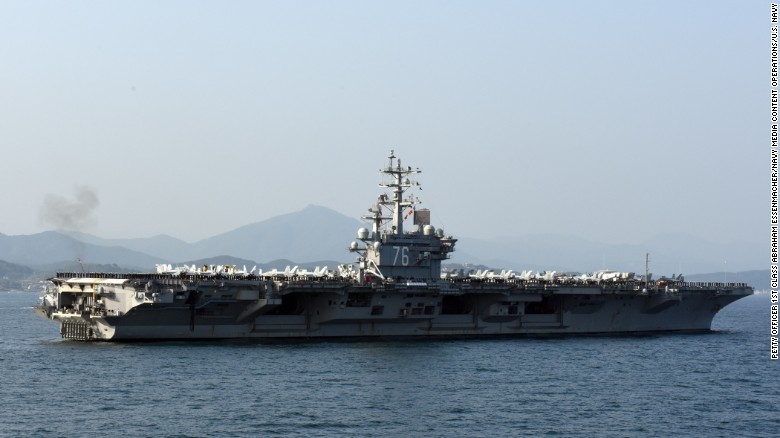
26 photos: U.S. aircraft carriers
Sailors aboard the U.S. Navy's only forward-deployed aircraft carrier, the Nimitz-class USS Ronald Reagan (CVN 76), man the rails while participating in the South Korean Navy's Fleet Review on October 23 in Busan. Click through the gallery to see more Navy carriers through the years.
Hide Caption
1 of 26
26 photos: U.S. aircraft carriers
Sailors test the countermeasure washdown system on the flight deck of the Nimitz-class aircraft carrier USS Dwight D. Eisenhower (CVN 69) during sea trials prior to returning to its homeport at Naval Station Norfolk in late August 2015.
Hide Caption
2 of 26
26 photos: U.S. aircraft carriers
A photo illustration of the U.S. Navy's Gerald R. Ford-class aircraft carrier USS John F. Kennedy (CVN-79). The ship's keel laying ceremony was celebrated Saturday, August 22, in Newport News, Virginia. The ship is expected to replace the USS Nimitz (CVN-68), scheduled for inactivation in 2025, in the Navy fleet. The newest Kennedy will be the second carrier of that name. The first John F. Kennedy (CVA-67) was the last conventionally powered carrier. It was decommissioned in 2007.
Hide Caption
3 of 26
26 photos: U.S. aircraft carriers
The Nimitz-class aircraft carrier USS George Washington (CVN 73) is seen from inside its sister ship, the USS Ronald Reagan (CVN 76), on August 7 off the coast of California as the two ships prepare for a "hull swap." Over 10 days in San Diego, much of the crew of each ship will transfer to the other. When completed, the Reagan will head to forward deployment in Japan, where the Washington had been. The Washington will head to Newport News, Virginia, for an overhaul.
Hide Caption
4 of 26
26 photos: U.S. aircraft carriers
Sailors spell out #USA with the American flag on the flight deck of the Nimitz-class aircraft carrier USS Theodore Roosevelt in the Persian Gulf in late June 2015. When the Roosevelt leaves the Gulf sometime in October, the U.S. Navy will be without a carrier in the important region for two months.
Hide Caption
5 of 26
26 photos: U.S. aircraft carriers
Three Nimitz-class aircraft carriers USS Carl Vinson (CVN 70), top, USS Ronald Reagan (CVN 76), center, and USS John C. Stennis (CVN 74) are pierside at Naval Air Station North Island near San Diego on June 12, 2015. The Vinson has just recently returned from a 10-month deployment. The Reagan is preparing for a move to Japan later this year and the Stennis was making a port call after steaming from its homeport of Bremerton, Washington.
Hide Caption
6 of 26
26 photos: U.S. aircraft carriers
The aircraft carrier USS Theodore Roosevelt departs Naval Station Norfolk, Virginia, on Wednesday, March 11, for a scheduled deployment. The Nimitz-class carrier's departure was delayed for two days after marine growth clogged sea water intakes. Divers went into the 36-degree water to clean out the intakes and allow the ship to get under way. The cold water created a fog that made it seem the ship was in a cloud.
Hide Caption
7 of 26
26 photos: U.S. aircraft carriers
A rainbow forms over the bow of the Nimitz-class aircraft carrier USS John C. Stennis as the ship steams in the Pacific Ocean on February 3, 2015.
Hide Caption
8 of 26
26 photos: U.S. aircraft carriers
The USS Abraham Lincoln, a Nimitz-class aircraft carrier, is seen near the coast of Indonesia in 2005. The carrier recently received a new anchor from the decommissioned USS Enterprise.
Hide Caption
9 of 26
26 photos: U.S. aircraft carriers
The USS Ranger (CV-61) arrives at Pearl Harbor, Hawaii, in 1993. The Forrestal-class carrier, which featured in the movie "Top Gun," is to be scrapped this year.
Hide Caption
10 of 26
26 photos: U.S. aircraft carriers
In this photo released by the U.S. Navy, a tugboat works alongside the decommissioned aircraft carrier USS Saratoga on Thursday, August 21, in Newport, Rhode Island. The Navy has paid a Texas recycling company a penny to dispose of the Saratoga, part of the Forrestal-class of "supercarrier" vessels built for the Atomic Age. The carrier was decommissioned 20 years ago.
Hide Caption
11 of 26
26 photos: U.S. aircraft carriers
Ben Hansen, a U.S. Navy boatswain's mate, and his wife, Jessica, join in the festivities as the Navy's newest nuclear-powered aircraft carrier, the USS Gerald R. Ford, gets christened in November in Newport News, Virginia. The Gerald R. Ford is the first ship in the Navy's newest class of aircraft carriers under the same name.
Hide Caption
12 of 26
26 photos: U.S. aircraft carriers
Lightning strikes over the flight deck of the USS John C. Stennis, another Nimitz-class aircraft carrier, as the ship moves through the Persian Gulf in 2007. All of the Navy's 10 active aircraft carriers are from the Nimitz class, which started in 1975 with the commission of the USS Nimitz.
Hide Caption
13 of 26
26 photos: U.S. aircraft carriers
Aircrew members are lifted from the flight deck of the USS John F. Kennedy during an exercise in 2002. The ship, which was decommissioned in 2007, was the only member of its class.
Hide Caption
14 of 26
26 photos: U.S. aircraft carriers
An F/A-18 Hornet launches from the USS Enterprise in 2007. The Enterprise, the world's first nuclear-powered aircraft carrier, was decommissioned in 2012. Like the John F. Kennedy, it was the only ship built in its class.
Hide Caption
15 of 26
26 photos: U.S. aircraft carriers
The Kitty Hawk class was named for the USS Kitty Hawk, seen here departing Yokosuka, Japan, in 2008. At that time, the Kitty Hawk was the oldest carrier in the U.S. Navy and the only conventional-power aircraft carrier still in commission. It was decommissioned in 2009.
Hide Caption
16 of 26
26 photos: U.S. aircraft carriers
The USS Independence, a member of the Forrestal class that preceded the Kitty Hawk class, heads up the East River in New York in 1959.
Hide Caption
17 of 26
26 photos: U.S. aircraft carriers
Helicopters sit on the flight deck of the USS Saipan during the mid-1950s. The ship was one of two members of the Saipan class.
Hide Caption
18 of 26
26 photos: U.S. aircraft carriers
The USS Midway, namesake of the Midway class of aircraft carriers, floats off the coast of North Vietnam in 1972. It was named after the Battle of Midway, when U.S. forces held back a Japanese attempt to take the Pacific atoll in 1942.
Hide Caption
19 of 26
26 photos: U.S. aircraft carriers
The USS Princeton, part of the Independence class, moves off the coast of Seattle in 1944.
Hide Caption
20 of 26
26 photos: U.S. aircraft carriers
The Essex-class USS Franklin burns after being hit by a Japanese dive bomber in 1945. The ship was named after Benjamin Franklin and nicknamed "Big Ben."
Hide Caption
21 of 26
26 photos: U.S. aircraft carriers
The USS Wasp burns in the Coral Sea after being struck by three torpedoes from a Japanese submarine in 1942. The ship, the only one of its class, would ultimately sink because of the damage.
Hide Caption
22 of 26
26 photos: U.S. aircraft carriers
B-25 bombers sit on the deck of the USS Hornet in the Pacific Ocean in 1942. The Hornet, one of three carriers in the Yorktown class, was the ship that launched the bombers flown by Air Force Lt. Col. James Doolittle and his pilots during an air raid in Tokyo four months after the attack on Pearl Harbor. It also was involved in the Battle of Midway.
Hide Caption
23 of 26
26 photos: U.S. aircraft carriers
Navy personnel work on board the USS Ranger circa 1942. The Ranger was the first ship to be designed and built specifically as an aircraft carrier. It was the only ship in its class.
Hide Caption
24 of 26
26 photos: U.S. aircraft carriers
There have actually been two aircraft carriers named after the Revolutionary War's Battle of Saratoga. The first USS Saratoga, seen here moving toward San Francisco's Golden Gate Bridge in 1945, was one of two members of the Lexington class of aircraft carriers.
Hide Caption
25 of 26
26 photos: U.S. aircraft carriers
The USS Langley, the Navy's first aircraft carrier and sole member of its class, steams off the coast of Baltimore in 1924.
Hide Caption
26 of 26

26 photos: U.S. aircraft carriers
Sailors aboard the U.S. Navy's only forward-deployed aircraft carrier, the Nimitz-class USS Ronald Reagan (CVN 76), man the rails while participating in the South Korean Navy's Fleet Review on October 23 in Busan. Click through the gallery to see more Navy carriers through the years.
Hide Caption
1 of 26
26 photos: U.S. aircraft carriers
Sailors test the countermeasure washdown system on the flight deck of the Nimitz-class aircraft carrier USS Dwight D. Eisenhower (CVN 69) during sea trials prior to returning to its homeport at Naval Station Norfolk in late August 2015.
Hide Caption
2 of 26
26 photos: U.S. aircraft carriers
A photo illustration of the U.S. Navy's Gerald R. Ford-class aircraft carrier USS John F. Kennedy (CVN-79). The ship's keel laying ceremony was celebrated Saturday, August 22, in Newport News, Virginia. The ship is expected to replace the USS Nimitz (CVN-68), scheduled for inactivation in 2025, in the Navy fleet. The newest Kennedy will be the second carrier of that name. The first John F. Kennedy (CVA-67) was the last conventionally powered carrier. It was decommissioned in 2007.
Hide Caption
3 of 26
26 photos: U.S. aircraft carriers
The Nimitz-class aircraft carrier USS George Washington (CVN 73) is seen from inside its sister ship, the USS Ronald Reagan (CVN 76), on August 7 off the coast of California as the two ships prepare for a "hull swap." Over 10 days in San Diego, much of the crew of each ship will transfer to the other. When completed, the Reagan will head to forward deployment in Japan, where the Washington had been. The Washington will head to Newport News, Virginia, for an overhaul.
Hide Caption
4 of 26
26 photos: U.S. aircraft carriers
Sailors spell out #USA with the American flag on the flight deck of the Nimitz-class aircraft carrier USS Theodore Roosevelt in the Persian Gulf in late June 2015. When the Roosevelt leaves the Gulf sometime in October, the U.S. Navy will be without a carrier in the important region for two months.
Hide Caption
5 of 26
26 photos: U.S. aircraft carriers
Three Nimitz-class aircraft carriers USS Carl Vinson (CVN 70), top, USS Ronald Reagan (CVN 76), center, and USS John C. Stennis (CVN 74) are pierside at Naval Air Station North Island near San Diego on June 12, 2015. The Vinson has just recently returned from a 10-month deployment. The Reagan is preparing for a move to Japan later this year and the Stennis was making a port call after steaming from its homeport of Bremerton, Washington.
Hide Caption
6 of 26
26 photos: U.S. aircraft carriers
The aircraft carrier USS Theodore Roosevelt departs Naval Station Norfolk, Virginia, on Wednesday, March 11, for a scheduled deployment. The Nimitz-class carrier's departure was delayed for two days after marine growth clogged sea water intakes. Divers went into the 36-degree water to clean out the intakes and allow the ship to get under way. The cold water created a fog that made it seem the ship was in a cloud.
Hide Caption
7 of 26
26 photos: U.S. aircraft carriers
A rainbow forms over the bow of the Nimitz-class aircraft carrier USS John C. Stennis as the ship steams in the Pacific Ocean on February 3, 2015.
Hide Caption
8 of 26
26 photos: U.S. aircraft carriers
The USS Abraham Lincoln, a Nimitz-class aircraft carrier, is seen near the coast of Indonesia in 2005. The carrier recently received a new anchor from the decommissioned USS Enterprise.
Hide Caption
9 of 26
26 photos: U.S. aircraft carriers
The USS Ranger (CV-61) arrives at Pearl Harbor, Hawaii, in 1993. The Forrestal-class carrier, which featured in the movie "Top Gun," is to be scrapped this year.
Hide Caption
10 of 26
26 photos: U.S. aircraft carriers
In this photo released by the U.S. Navy, a tugboat works alongside the decommissioned aircraft carrier USS Saratoga on Thursday, August 21, in Newport, Rhode Island. The Navy has paid a Texas recycling company a penny to dispose of the Saratoga, part of the Forrestal-class of "supercarrier" vessels built for the Atomic Age. The carrier was decommissioned 20 years ago.
Hide Caption
11 of 26
26 photos: U.S. aircraft carriers
Ben Hansen, a U.S. Navy boatswain's mate, and his wife, Jessica, join in the festivities as the Navy's newest nuclear-powered aircraft carrier, the USS Gerald R. Ford, gets christened in November in Newport News, Virginia. The Gerald R. Ford is the first ship in the Navy's newest class of aircraft carriers under the same name.
Hide Caption
12 of 26
26 photos: U.S. aircraft carriers
Lightning strikes over the flight deck of the USS John C. Stennis, another Nimitz-class aircraft carrier, as the ship moves through the Persian Gulf in 2007. All of the Navy's 10 active aircraft carriers are from the Nimitz class, which started in 1975 with the commission of the USS Nimitz.
Hide Caption
13 of 26
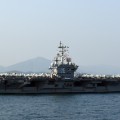
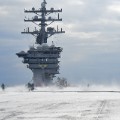
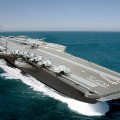



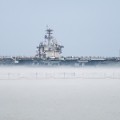
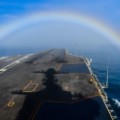

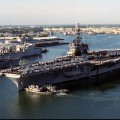
















Story highlights
Armed F/A-18 jets launched to intercept Russian planes, the Navy says
Russian planes did not respond to U.S. ship, were about a mile away from USS Ronald Reagan
U.S. ships were in exercises with South Korean navy
(CNN)The U.S. Navy launched four armed fighter jets to intercept two Russian Tu-142 Bear aircraft that were flying near the aircraft carrier USS Ronald Reagan in the Pacific Ocean, the Navy said Thursday.
The four F/A-18 fighter jets were sent as "standard operating procedure" to escort planes flying near Navy ships, according to a Navy statement.
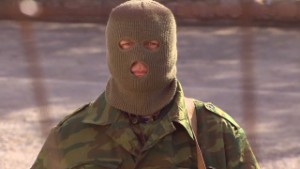
By the numbers: Putin's firepower 00:31
The Russian aircraft came within one nautical mile and were flying at 500 feet in altitude while the 100,000-ton warship was participating in a bilateral training exercise with South Korea on Tuesday.
The Navy said a ship escorting the Reagan during exercises near the Korean Peninsula hailed the Russian planes but did not get a response.
"It is standard operating procedure for U.S. planes to escort aircraft flying in the vicinity of U.S. Navy ships," Navy Cmdr. William J. Marks said in an email. "This type of interaction is not unprecedented. Overall I would characterize the interaction as safe."
Tuesday's encounter with the two Russian Tu-142s, naval reconnaissance versions of the Russian Tu-95 Bear bombers, was first reported by the military newspaper Stars and Stripes.
A U.S. ship followed the Russian planes as they moved away from the Reagan, according to the Stripes report.
In a separate release, the Navy identified the ships involved in the exercises as the guided missile cruiser USS Chancellorsville and the guided-missile destroyers USS Mustin, USS Fitzgerald and USS Curtis Wilbur.
12 photos: Russian warplane intercepts
An armed MiG-31 Foxhound photographed from below by a Norwegian Royal Air Force interceptor.
Hide Caption
7 of 12
12 photos: Russian warplane intercepts
A Russian Il-78 tanker refuels a Tu-95 Bear bomber in a photograph taken by a Norwegian warplane.
Hide Caption
8 of 12
12 photos: Russian warplane intercepts
Two Russian Sukhoi Su-34 fighter bombers, nicknamed the Fullback by NATO, as photographed by Finnish Air Force F/A-18 Hornet fighters.
Hide Caption
9 of 12
12 photos: Russian warplane intercepts
Finnish fighter jets photographed this Russian Tu-95 Bear bomber.
Hide Caption
10 of 12
12 photos: Russian warplane intercepts
Two Tupolev Tu-22M aircraft intercepted by Finnish fighter planes.
Hide Caption
11 of 12
12 photos: Russian warplane intercepts
A Russian Tupolev Tu-95 Bear bomber intercepted by Finnish fighter planes.
Hide Caption
12 of 12
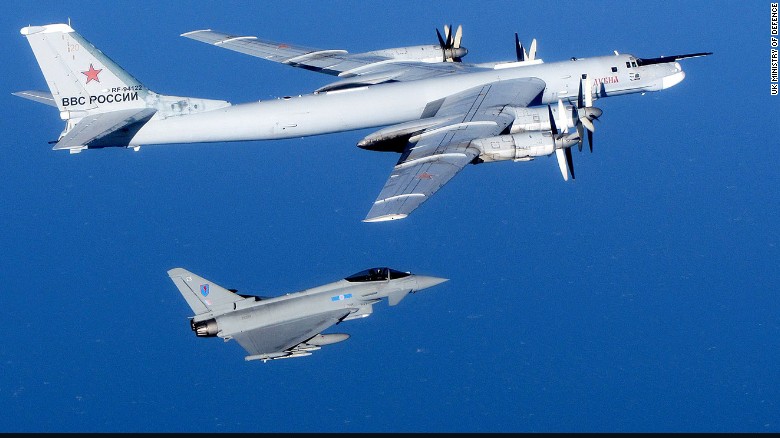
12 photos: Russian warplane intercepts
A Russian Tu-95 Bear bomber is escorted by a British Royal Air Force Typhoon fighter during an intercept in September 2014. Click through the gallery to see other intercepts in late 2014.
Hide Caption
1 of 12
12 photos: Russian warplane intercepts
NATO Secretary General Jens Stoltenberg said in November that alliance fighters had intercepted Russian warplanes as they flew close to NATO countries more than 400 times in 2014, the kind of Russian air activity not seen since the Cold War.
Hide Caption
2 of 12
12 photos: Russian warplane intercepts
An armed MiG-31 intercepted by Norwegian planes. The plane is nicknamed the Foxhound by NATO.
Hide Caption
3 of 12
12 photos: Russian warplane intercepts
An armed Tu-22M supersonic bomber, nicknamed the Backfire by NATO, was photographed by Norwegian fighter jets.
Hide Caption
4 of 12
12 photos: Russian warplane intercepts
A look at a Russian Tu-22M from below as taken by a Norwegian Royal Air Force fighter plane.
Hide Caption
5 of 12
12 photos: Russian warplane intercepts
A Su-24 attack aircraft, nicknamed the Fencer by NATO, was photographed by a Norwegian warplane.
Hide Caption
6 of 12
12 photos: Russian warplane intercepts
An armed MiG-31 Foxhound photographed from below by a Norwegian Royal Air Force interceptor.
Hide Caption
7 of 12
12 photos: Russian warplane intercepts
A Russian Il-78 tanker refuels a Tu-95 Bear bomber in a photograph taken by a Norwegian warplane.
Hide Caption
8 of 12
12 photos: Russian warplane intercepts
Two Russian Sukhoi Su-34 fighter bombers, nicknamed the Fullback by NATO, as photographed by Finnish Air Force F/A-18 Hornet fighters.
Hide Caption
9 of 12
12 photos: Russian warplane intercepts
Finnish fighter jets photographed this Russian Tu-95 Bear bomber.
Hide Caption
10 of 12
12 photos: Russian warplane intercepts
Two Tupolev Tu-22M aircraft intercepted by Finnish fighter planes.
Hide Caption
11 of 12
12 photos: Russian warplane intercepts
A Russian Tupolev Tu-95 Bear bomber intercepted by Finnish fighter planes.
Hide Caption
12 of 12

12 photos: Russian warplane intercepts
A Russian Tu-95 Bear bomber is escorted by a British Royal Air Force Typhoon fighter during an intercept in September 2014. Click through the gallery to see other intercepts in late 2014.
Hide Caption
1 of 12
12 photos: Russian warplane intercepts
NATO Secretary General Jens Stoltenberg said in November that alliance fighters had intercepted Russian warplanes as they flew close to NATO countries more than 400 times in 2014, the kind of Russian air activity not seen since the Cold War.
Hide Caption
2 of 12
12 photos: Russian warplane intercepts
An armed MiG-31 intercepted by Norwegian planes. The plane is nicknamed the Foxhound by NATO.
Hide Caption
3 of 12
12 photos: Russian warplane intercepts
An armed Tu-22M supersonic bomber, nicknamed the Backfire by NATO, was photographed by Norwegian fighter jets.
Hide Caption
4 of 12
12 photos: Russian warplane intercepts
A look at a Russian Tu-22M from below as taken by a Norwegian Royal Air Force fighter plane.
Hide Caption
5 of 12
12 photos: Russian warplane intercepts
A Su-24 attack aircraft, nicknamed the Fencer by NATO, was photographed by a Norwegian warplane.
Hide Caption
6 of 12
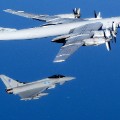
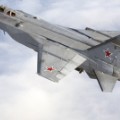



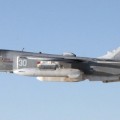






An encounter like Tuesday's between U.S. and Russian forces is nothing new.
On July 4, U.S. fighter jets intercepted Russian fighters off the coasts of California and Alaska.
"Good morning, American pilots. We are here to greet you on your Fourth of July Independence Day," the Russian fliers radioed to their U.S. counterparts, according to the North American Aerospace Defense Command.
And in June, the Navy released video of a Russian Su-24 jet flying past the right side of the guided missile destroyer USS Ross as it cruised in international waters in the Black Sea off Crimea.
Encounters such as these were common during the Cold War. They subsided with its end but picked up again under current Russian President Vladimir Putin, Nick de Larrinaga, Europe editor for IHS Jane's Defence Weekly, told CNN last summer.
"Over the last few years and particularly this year and last year, with the start of the Ukraine crisis, Russia has picked up the number of sorties," he said.
"His view is that Russia's political standing and the respect accorded to it have fallen away very much since the end of the Cold War," he said.
Putin wants to show Russia is "still a global military power and a force to be reckoned with," de Larrinaga said.
CNN's Laura Smith-Spark contributed to this report.
Sem comentários:
Enviar um comentário